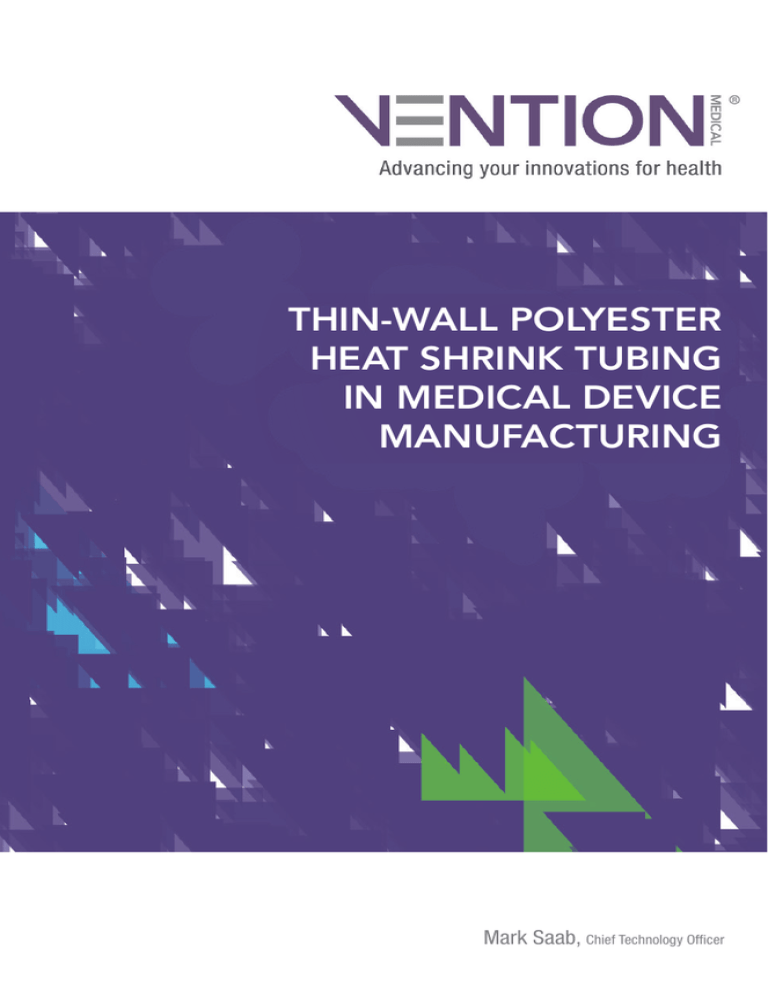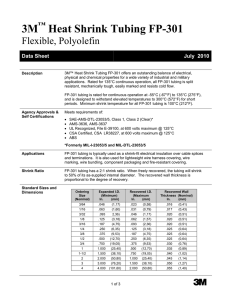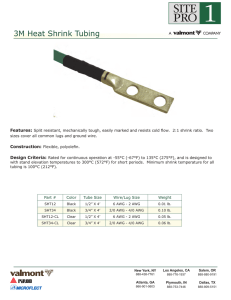
THIN-WALL POLYESTER
HEAT SHRINK TUBING
IN MEDICAL DEVICE
MANUFACTURING
Mark Saab, Chief Technology Officer
THIN-WALL POLYESTER HEAT SHRINK TUBING
IN MEDICAL DEVICE MANUFACTURING
PAGE 1
INTRODUCTION
The demand for less-invasive medical procedures is a major driving force in the medical
device industry today. Smaller and thinner is better, especially in catheters, endoscopes, and
other devices inserted into the body. Designers are looking for new ways to downsize existing
devices and satisfy the requirements of minimally invasive procedures. The industry is also
under pressure to build more features into devices without increasing their profile (size). Thinwall heat shrink tubing can help designers meet this demand across a range of applications by
reducing diameters and improving production processes.
Vention Medical has developed a proprietary process to manufacture thin-wall heat
shrink tubing from Polyester (specifically, polyethylene terephthalate, or PET) that exhibits
extraordinary tensile strength, even with walls as thin as 0.00015”.
This paper begins with a brief comparison of the key properties of thermoplastic materials
used in the manufacture of high-end medical heat shrink tubing, then discusses the
advantages of PET for thin-wall heat shrink tubing for the following applications:
►►
►►
►►
►►
►►
►►
►►
►►
►►
Creating Variable-Stiffness Catheters
Electrical Insulation
Protective Covering/Encapsulation & Bundling
Tube Joining & Transitioning
Tube Marking and Printing
Cather Shaft Lamination
Catheter Tip Forming
Micro Hose Clamps
Masking Procedures
MATERIALS COMPARISON –
PROPERTIES OF HEAT SHRINK TUBING
This table compares the properties of the primary materials used for thin-wall heat shrink
tubing.
WALL THICKNESS
SHRINK TEMP.
SHINK RATIO
STERILIZATION
STRENGTH
PVC
MATERIAL
>.0.005”
Medium
2:1
Most
Low
COST
Low
Polyolefin
>0.005”
Medium
2:1 to 4:1
Most
Low
Low/Medium
PET
0.00015 to 0.004”
Low/Medium
1.1:1 to 3:1*
Most
High
High
FEP
>0.002”
High
1.13:1 to 1.6:1
No Gamma
Low
High
PTFE
>0.002”
Very High
1.3:1 to 4.1
No Gamma
Low
High
* Recovery greater than 20% can be accomplished by drawing while shrinking
PET is the clear leader in terms of thin walls and high strength. It is 10 to 100 times thinner
than all other heat shrink tubing and more than 10 times stronger. Tube walls of 0.00015” to
0.004” can be produced from PET and still maintain high hoop strength. That compares with
>0.002” for Fluoropolymers (FEP, PTFE) and >0.005” for Polyolefin and PVC. PET also has the
lowest shrink temperature (185°F/85°C) of the group, which enables processing of delicate
substrates without heat degradation.
As noted in the chart above, the cost of PVC is low, Polyolefin is low to medium, and
Fluoropolymers and PET are higher. However, the cost of tubing for high-end medical
devices is generally outweighed by other factors, such as the need for unique mechanical
characteristics, product quality, precise sizing, availability across a broad range of diameters
and wall thicknesses, and supplier delivery and reliability.. In addition, cost savings can often
be realized by using high-end components that eliminate upstream or downstream processes,
reduce defect rate, or deliver functional performance that warrants a premium price in the
marketplace.
While Fluoropolymers offer outstanding lubricity, a significant drawback is their very high
shrink temperature (420°F - 650°F/215°C - 343°C). For FEP, this can lead to process
inefficiencies and increased defect rates. In the case of PTFE, it precludes many catheter
and plastic component applications altogether. Fluoropolymers cannot be sterilized with
gamma radiation, which is a negative in an industry that is moving away from ethylene
oxide sterilization. In addition, the walls cannot be made nearly as thin as PET tubing, and
Fluoropolymers would fail to retain any useful strength at that dimension. Wall thickness
THIN-WALL POLYESTER HEAT SHRINK TUBING
IN MEDICAL DEVICE MANUFACTURING
PAGE 3
tolerances also tend to be quite high, which must be compensated for in device design.
Because of these constraints, Fluoropolymer heat shrink tubing is typically used as a
processing aid, or as an insulative and protective covering for metal components and devices.
PET heat shrink tubing offers several key advantages over other materials, including
dimensional stability, ultra-smooth surface finish, and the ability to achieve extremely thin
walls and maintain a very high tensile strength.. PET is able to maintain high strength in both
the hoop and axial directions through a proprietary process that biaxially orients the PET during
production of the tubing. Because of its mechanical properties, PET tubing can be made very
thin, yet still perform as well as—and in some cases better than—tubing that is 10 times
thicker. The tubing also has outstanding flex fatigue properties and toughness.
KEY PROPERTIES OF POLYESTER (PET) HEAT SHRINK TUBING
Wall Thickness
Ultra-thin (0.00015” - 0.004”)
Tensile Strength
Very high (>20,000 PSI)
Electrical Insulation
One of the highest dielectric strength ratings of any thermoplastic material
Dielectric strength: >4,000 V/mil (60Hz) Dielectric constant: 3.3
Dissipation factor: 0.0025
Volume resistivity: 1018 Ohm-cm
Surface resistivity: 1014 Ohm/square
Shrink Temperature
185°F to 374°F (85°C to 190°C)
Melt Point
High, 473°F (245°C)
Shrink Ratio
5%-15% shrinkage is typical if unconstrained – recovery up to 3:1 can be
achieved if drawn or stretched during application
Surface Finish
Ultra smooth, hard, glossy finish
Color/Clarity
Optically clear or can be pigmented
Bondability
Can be bonded using a wide range of adhesives (surface treatment recommended)
Flex Fatigue
Very high
Biocompatibility
Meets all requirements for disposable devices
With PET tubing, shrink rate is a function of temperature: the higher the temperature, the
higher the material recovery. The shrinking temperature ranges from approximately 185°F to
374°F (85°C to 190°C). Unrestricted, the tubing will shrink both radially and axially, and the
best overall performance is achieved with minimal shrinkage (15% or less). Whenever very
high radial shrinkage is required (up to 3:1), the PET heat shrink tubing can be drawn axially
while it is being heated.
APPLICATIONS & ADVANTAGES OF POLYESTER (PET)
HEAT SHRINK TUBING
Creating Variable-Stiffness Catheters
Because of its ultra-thin walls, PET heat shrink tubing can be used to add stiffness to catheters
without significantly adding to the profile (size) of the device. By using different thicknesses
of heat shrink tubing along the length of the catheter, varying degrees of flexibility can be
achieved for improved control of the device. This quick and easy tubing application eliminates
the need for joining dissimilar materials or adding braid to sections of a catheter to achieve
multiple zones of stiffness. For example, some manufacturers use heat shrink tubing with a
one-mil wall at the back end of a catheter, a half-mil in the middle, a quarter-mil near the end,
and none at the tip. This provides varying degrees of stiffness along a catheter’s length and full
flexibility at its tip.
Key advantages of using PET tubing in creating variable-stiffness catheters are:
Very thin; adds very little device dimensions
►► High-flex modulus provides needed stiffness
►► Can be applied in thicknesses as low as 0.00015”
►► Multiple stiffness zones can be created by adjusting thickness rather than changing materia
►►
Electrical Insulation
High dielectric and resistive properties make
PET heat shrink tubing an effective electrical
insulation material that adds little dimension
because of its ultra-thin walls. It can be used
over needles to protect the surface of the skin
from being burned during electrical stimulation,
or used to insulate electrical components and
VARIOUS COILS COVERED WITH CLEAR PET HEAT SHRINK TUBING
wiring on catheters and other devices. Some
FOR INSULATION.
manufacturers are using PET heat shrink tubing to replace a coating process for electrical
insulation of metal shafts. Due to the extremely thin layers that can be achieved with coatings,
PET was found to be the only heat shrink tubing that was viable for this application. Using PET
in this way also greatly reduces the chance of pin holes that can develop in coated surfaces,
THIN-WALL POLYESTER HEAT SHRINK TUBING
IN MEDICAL DEVICE MANUFACTURING
PAGE 5
leading to a repeatable, consistent, and efficient alternative that eliminates the solvents and
chemicals associated with coating processes.
Key advantages of using PET tubing as an electrical insulator are:
►►
►►
►►
Outstanding toughness
High dielectric and resistivity properties
Very thin; adds very little device dimensions
Protective Covering/Encapsulation & Bundling
PET heat shrink tubing is often used to cover
braided catheter shafts, spring coils, radiopaque
marker bands, and other parts that require a
thin but tough outer layer. The tubing provides
smooth transitions over sharp edges and can
be sealed against fluid leakage. One
manufacturer uses PET over a rotary spring
POLYIMIDE TUBINGS BUNDLED TOGETHER (TOP) AND HYPOTUBE
AND POLYIMIDE TUBING BUNDLED TOGETHER (BOTTOM)
cutter to keep debris from clogging the coils
and to act as a bearing surface inside the device. It provides a fluid seal, yet the cutter remains
flexible, and the very thin walls add virtually no dimensional increase to the device.
Ultra-thin-wall tubing allows designers to downsize or add features to endoscopes and other
devices without a size increase. Unique devices can be produced using PET heat shrink tubing
to bundle various components into the smallest possible space. Components such as plastic
and metal tubing, wires, and optical fibers can be compressed and protected. Connecting
tubes at the ends of a device also can be made of thin-wall PET to save valuable space. Using
PET heat shrink tubing can free up enough space to add another working channel inside an
endoscope. Or it might enable the designer to reduce the size of a device by a whole French
catheter size.
Key advantages of using PET tubing as a protective cover or encapsulation material are:
►►
►►
►►
►►
Very thin; adds very little device dimensions
Smooth transitions over sharp edges
Strain relief to prevent kinking
Quick, easy application
►►
►►
Repeatable and consistent
Adhesive can be UV-cured through clear tubing
Tube Joining & Transitioning
Clear PET heat shrink tubing can be used effectively in fusing tubes together. Typically, tubes of
dissimilar properties—one stiff and one flexible—are joined. An easy way to accomplish this is
to insert a wire mandrel in the tube ends to keep them from collapsing, butt the two
ends together, and shrink a piece of tubing over them. Since PET tubing has a low shrink
temperature, a broad range of materials can be joined without causing distortion.
The shrinking process squeezes the tubes and holds them together tightly during fusing.
Because of PET’s high melt temperature, the heat applied to fuse the tube ends does
not melt the heat shrink tubing. After the tubes are joined, the heat shrink tubing can be left on
or peeled off to leave an ultra-smooth surface finish.
Nicking the shrink tubing at an end before shrinking facilitates removal. Since the PET tubing is
clear, the operator can see when the tubes are fused. The ability to monitor the process is very
useful in product development and production to avoid applying too much or too little heat.
Key properties of PET heat shrink tubing in tube joining are:
►►
►►
►►
►►
►►
►►
►►
Low shrink temperature, allowing initial application without part distortion
High melt temperature, allowing use of a high enough temperature to get the substrates to melt and flow together
Axial shrinkage that tends to draw components together, resulting in superior
butt welds
Very smooth surface finish after joining
Easy to removed if required
Does not stick to most materials
Clear material that enables monitoring of the process
Tube Marking & Printing
Depth marks and printing can easily be added to catheters and metal shafts with heat shrink
tubing. Typically, thin bands of colored heat shrink tubing are used for marking. They can be
accurately positioned using the proper techniques. Labeling information can be added by THIN-WALL POLYESTER HEAT SHRINK TUBING
IN MEDICAL DEVICE MANUFACTURING
PAGE 7
preprinting on the heat shrink tubing then applying it to the product, which avoids the need to send the devices themselves to a printer for labeling or to bring printing
inks and solvents into the manufacturing facility for in-
house printing. Some products, such as catheters made from high-density Polyethylene, cannot be readily
printed without surface treatment, adding more PAD PRINTED HEAT SHRINK TUBING
complexity. Manufacturers who print on their products can use clear heat shrink tubing over the printed area to protect it. The ultra-thin wall of PET
heat shrink tubing does not increase the diameter of the product substantially.
Key properties of PET heat shrink tubing influencing marking and printing are:
►►
►►
►►
►►
►►
►►
Can be printed with any color and graphic
Available in a variety of colors
Very thin; adds very little device dimensions
High-gloss surface provides quality appearance
Can be accurately placed using proper techniques
Can be used to protect printing on the product
Catheter Shaft Lamination
Manufacturers of reinforced, variable-stiffness catheters have a constant need for heat shrink
tubing that can be easily loaded onto a catheter assembly, processed through a heat source
to fuse components together, then removed and discarded without imparting any undesired
effects to the substrate. PET heat shrink tubing currently satisfies most requirements for long,
continuous-reflow applications. Most notably, its low recovery temperature and thin walls allow
for gentle melting of substrate materials without affecting cycle time and smooth ID transfers
to processed components (resulting in a superior surface finish). In addition, and the ability to
draw during recovery means a wide range of diameters can be accommodated on a single part
(up to 3:1 recovery ratio if actively tensioned during heating). Due to its thin walls, traditional
removal techniques such as lengthwise skiving are not easily employed with PET heat shrink
tubing. Specially designed skiving fixtures may be required. The material readily peels in a
spiral fashion, allowing for simple manual removal from any assembly, without skiving.
See the chart below for recommended processing parameters.
Sizing
Reflow Settings
(Hot Box, Laminator or Oven)
Material Compatibility
- Shrink ratios:
- Tight fit is best:
- Wall thickness range (in):
1.1:1 up to 3:1*
15% gap or less**
0.00015 – 0.004
- Material shrink temp range:
- Material melt temp:
- Recommended set temp range
185°F to 374°F (85°C to 190°C)
473°F (245°C)
300°F to 450°F (149°C to 232°C)
PET releases easily from the most common thermoplastics. However, urethanes and some low-durometer materials tend to tack to the PET and may
require a resting period (~1hr) or may not be compatible. Run test samples
with these materials.
Key properties of PET heat shrink tubing in catheter shaft lamination are:
►►
►►
►►
►►
►►
Low shrink temperature for gentle recovery of common thermoplastics
Ultra-smooth surface finish on ID that transfers to processed part
Releases well from most materials
Clear material enables visible monitoring of the process
High shrink ratio can be achieved with drawing, accommodating variable-diameter
Catheter Tip Forming
The low shrink temperature and high melt temperature of PET heat shrink tubing enables it to be used very effectively to form smoothly tapered tips on the ends of catheters. In the initial operation, a rod is inserted in a catheter
to support the ID; a section of
heat shrink tubing is slid over the PET HEAT SHRINK USED TO CREATE A SMOOTH, TAPERED TIP ON
DISTAL END OF CATHETER
end of the catheter, leaving a portion extended beyond the tip of the support rod; and heat is applied to shrink the tubing to the
substrate. Once attached, additional heat causes the substrate to melt and flow. Pulling on the
shrink tube draws the catheter tube to a very thin, smooth tip. Since the shrink tubing is clear,
the operator can monitor the process. The shrink tubing is peeled off and the support rod is
removed to reveal the finished product.
THIN-WALL POLYESTER HEAT SHRINK TUBING
IN MEDICAL DEVICE MANUFACTURING
PAGE 9
Key properties of PET heat shrink tubing in catheter-tip forming are:
►►
►►
►►
►►
►►
►►
►►
Low shrink temperature allows initial application without part distortion
High melt temperature allows use of a high enough temperature to cause the
substrate to melt and flow
Very smooth surface finish after forming
Easily removed
Does not stick to most materials
Clear material enables visual monitoring of the process
Shrink tube can be drawn down when heated to get a very thin smooth taper
Micro Hose Clamps
Bands of heat shrink tubing
can be used as micro hose
clamps on balloon catheters
to reinforce bonds and help
prevent failure under pressure.
A narrow band of heat shrink
tubing is applied over the end
of the balloon. The PET tubing,
with its high hoop strength,
grips the part much like a
HEAT SHRINK TUBING APPLIED OVER LATEX BALLOON ENDS TO ACT AS HOSE
CLAMPS
hose clamp, reinforcing the
bond and keeping it from lifting off. It also provides a smooth transition without adding
significantly to the bond diameter. The tubing can also be used to terminate braiding, spring
coils, and other parts to provide a smooth transition.
Key properties of PET heat shrink tubing in micro hose clamp applications are:
►►
►►
►►
►►
►►
Adds substantial hoop strength to reinforce bonds
Very thin; adds very little device dimensions
Can help smooth diameter transitions
Can be used to terminate braiding, springs, etc.
Adhesive can be UV-cured through the clear tubing
Masking Procedures
This is a simple but very effective application of PET heat shrink tubing for masking areas
during coating operations. One manufacturer requires a white coating over a clear balloon, but
the neck must remain uncoated so that a UV-curable adhesive can be used to bond it to the
catheter. A piece of heat shrink tubing is applied to the neck, then the balloon is dipped in the
coating. After it dries, the heat shrink tubing is peeled away, leaving the neck uncoated. The
key to this application is the thinness of the PET tubing. Thicker heat shrink tubing would leave
a thick edge of coating material on the balloon, unlike the ultra-thin-wall PET tubing.
Another manufacturer applies a slippery coating to a length of wire that has a fine spring coil
at the end. PET heat shrink tubing is used to mask the spring to keep it from being coated
during the dipping process. The low shrink temperature permits the masking operation without
heat distortion, and the tight heat shrink fit prevents the coating from flowing into the spring.
Afterwards, the PET tubing is easily peeled away.
Key properties of PET heat shrink tubing in masking applications are:
►►
►►
►►
►►
Very thin wall to prevent thick buildup at edge
Low shrink temperature allows application without heat distortion
Easily removed
Tight heat shrink fit on substrate
CONCLUSION
Many of the applications discussed here are made possible because of the unique properties
of PET heat shrink tubing. Other tubes are simply too thick, or lack unique features like smooth
surface finish and low recovery temperature. Designers often do not have enough space to
incorporate heat shrink tubing with walls of 0.005” thick or sometimes even 0.001” thick in
their novel devices. The alternative would be to do the job in some other way, or to accept
a bulkier product. But the ultra-thin walls and related properties of this tubing make it an
enabling technology for designers as they design and build medical devices for today’s market
requirements and tomorrow’s patient needs.
ABOUT VENTION
Vention Medical is a global integrated solutions partner with over 30 years of experience in
design, engineering, and manufacturing of complex medical devices and components. Vention
Medical specializes in components and services used in interventional and minimally invasive
surgical products including catheters, balloons, extrusions, polyimide and composite tubing,
heat shrink tubing, braid-reinforced shafts, cleanroom injection molding, and finished device
assembly and packaging.
ventionmedical.com /heatshrinktubing
603.327.0600
© 2014 Vention Medical. All rights reserved. VENACthinwallhst_W1.1



